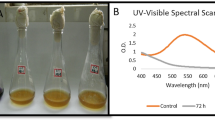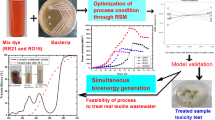Abstract
Some experiments were conducted to study some electrochemical factors affecting the bacterial reduction (cleavage) of azo dyes, knowledge of which will be useful in the wastewater treatments of azo dyes. A common mixed culture was used as a test organism and the reductions of Acid Yellow 4, 11, 17 and Acid Yellow BIS were studied. It was found that the azo dyes were reduced at different rates, which could be correlated with the reduction potential of the azo compounds in cyclic voltammetric experiments. Acid Yellow BIS (E r − 616.75 mV) was reduced at the highest rate of 0.0284 mol g dry cell weight−1 h−1, Acid Yellow 11 (E r − 593.25 mV) at 0.0245 mol g dry cell weight−1 h−1 and Acid Yellow 4 (E r − 513 mV) at 0.0178 mol g dry cell weight−1 h−1. At the same time, the decolourization rate of Acid Yellow 17 (E r − 627.5 mV) was 0.0238 mol g dry cell weight−1 h−1, which was affected by the nature of chlorine substituent. Reduction of these azo dyes did not occur under aeration conditions. These studies with a common mixed culture indicate that the reduction of azo dyes may be influenced by the chemical nature of the azo compound. The reduction potential is a preliminary tool to predict the decolourization capacity of oxidative and reductive biocatalysts.
Similar content being viewed by others
References
Bourbonnais R, Leech D, Paice MG, (1998) Electrochemical analysis of the interaction of laccase with lignin model compounds J. Biochim. Biophys. Acta. 1379: 381–390
Bragger JL, Lloyd AW, Soozandehfar SH, Bloomfield SF, Martin GP, (1997) Investigation into the azo reducing activity of a common colonic microorganism J. Int. J. Pharm. 157: 61–71
Bromley KCA., Knapp J.S., Zhang Z., Gray N.C.C., Hetherdige M.J, Evans M.R, (2000). Decolourization of an azo dye by unacclimated activated sludge under anaerobic conditions Water Res. 34:4410–4418
Eriksson A, Nyholm L, (1999) A comparison of the electrochemical properties of some azosalicylic acids at glassy carbon electrodes by cyclic and hydrodynamic voltammetry J. Electrochem. Acta. 44:4029–4040
Y Fu T Viraraghavan 2001 Fungal decolorization of dye wastewaters: a review Bioresource Technol 79 251–262
Knapp JS, Newby PS, (1995) The microbiological decolourization of an industrial effluent containing a diazo-linked chromophore J. Water. Res 29:1807–1809
Mandić Z, Nigović B, Simunić B, (2003) The mechanism and kinetics of the electrochemical ć cleavage of azo bond of 2-hydroxy−5-sulfophenyl-azo-benzoic acids J. Electrochem. Acta. 49:607–615
Schacht E, Gevaert A, Kenawy ER, Molly K, Verstraete W, Adriaensens P, Carleer R, Gelan J, (1996) Polymers for colon specific drug delivery J. Control. Release 39:327–338
Semde R, Pierre D, Geuskens G, Devleeschouwer M, Moes AJ, (1998) Study of some important factors involved in azo derivative reduction by Clostridium perfringens J. Int. J.Pharm. 161: 45–54
Supaka N, Juntongjin K, Damronglerd S, Delia ML, Strehaiano P, (2004) Microbial decolourization of reactive azo dyes in a sequential anaerobic-aerobic system J. Chem. Eng. 99:169–176
Suzuki T, Timofei S, Kurunczi L, Dietze U, Schüürmann G, (2001) Correlation of aerobic biodegradability of sulfonated azo dyes with the chemical structure J. Chemosphere. 45:1–9
Acknowledgement
This study was supported by the Cross-Century Talent Fund of National Education Committee of China. The four dyes used in the study were kindly provided by Doctor Cui Zhihua.
Author information
Authors and Affiliations
Corresponding author
Rights and permissions
About this article
Cite this article
Guo, J., Zhou, J., Wang, D. et al. Correlation of anaerobic biodegradability and the electrochemical characteristic of azo dyes. Biodegradation 17, 341–346 (2006). https://doi.org/10.1007/s10532-005-9003-0
Accepted:
Published:
Issue Date:
DOI: https://doi.org/10.1007/s10532-005-9003-0




